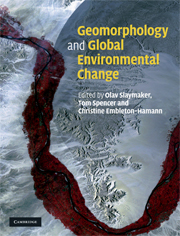Book contents
- Frontmatter
- Contents
- List of contributors
- Preface
- Acknowledgements
- List of acronyms and abbreviations
- 1 Landscape and landscape-scale processes as the unfilled niche in the global environmental change debate: an introduction
- 2 Mountains
- 3 Lakes and lake catchments
- 4 Rivers
- 5 Estuaries, coastal marshes, tidal flats and coastal dunes
- 6 Beaches, cliffs and deltas
- 7 Coral reefs
- 8 Tropical rainforests
- 9 Tropical savannas
- 10 Deserts
- 11 Mediterranean landscapes
- 12 Temperate forests and rangelands
- 13 Tundra and permafrost-dominated taiga
- 14 Ice sheets and ice caps
- 15 Landscape, landscape-scale processes and global environmental change: synthesis and new agendas for the twenty-first century
- Index
11 - Mediterranean landscapes
Published online by Cambridge University Press: 05 July 2015
- Frontmatter
- Contents
- List of contributors
- Preface
- Acknowledgements
- List of acronyms and abbreviations
- 1 Landscape and landscape-scale processes as the unfilled niche in the global environmental change debate: an introduction
- 2 Mountains
- 3 Lakes and lake catchments
- 4 Rivers
- 5 Estuaries, coastal marshes, tidal flats and coastal dunes
- 6 Beaches, cliffs and deltas
- 7 Coral reefs
- 8 Tropical rainforests
- 9 Tropical savannas
- 10 Deserts
- 11 Mediterranean landscapes
- 12 Temperate forests and rangelands
- 13 Tundra and permafrost-dominated taiga
- 14 Ice sheets and ice caps
- 15 Landscape, landscape-scale processes and global environmental change: synthesis and new agendas for the twenty-first century
- Index
Summary
Introduction
Environments characterised by a Mediterranean climate are located on the western rims of continents in the latitudinal bands 30 – 45° N and S. The basic influences are the tropical (summer) and polar (winter) air masses with their spring and autumn north – south and south – north movement. The most defining climate characteristic is the summer drought; maximum rains occurring during the cold seasons, which can be autumn, winter or spring. Continental winds associated with Mediterranean climates (e.g. cers, bora, tramontane, mistral) are dry and often strong. The largest area with these climatic characteristics is on the western side of the Eurasian continent, around the Mediterranean Sea, after which this special type of climate is named. Other areas with this climate are: South Africa, California, Chile and Western Australia (Fig. 11.1). But these different bio-climatic zones have been subjected to completely different anthropogenic processes, resulting in different landscapes. While the Mediterranean basin was the birthplace of western civilisation and has supported human activities over several millennia, the other Mediterranean areas did not become densely populated until the last three or four centuries, and even now they have a lower population density than the Mediterranean basin. Only in their more populated areas do they present similarities with the socioecological landscapes of the ‘old’ Mediterranean countries. This chapter examines how the main drivers of global environmental change – climate, hydrology, relief, sea level and human activity – have had, and are having, an impact in Mediterranean environments and how these impacts may change in the near future with global climate change.
One of the most marked characteristics of Mediterranean landscapes is the complex mosaic of environments, characterised by important intra-Mediterranean climate variations ranging from the semi-arid to the subhumid, due to their locational proximity to arid and humid lands.
- Type
- Chapter
- Information
- Geomorphology and Global Environmental Change , pp. 297 - 320Publisher: Cambridge University PressPrint publication year: 2009



